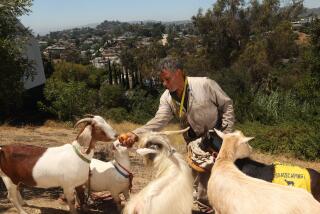‘Judas Goats’ Help Navy Rid San Clemente Island of Beasts
- Share via
SAN DIEGO — After 18 years of battling the formidable goats of San Clemente Island, the U.S. Navy says it is about to eradicate them for good by using a new program based on a simple premise: goats hate to be alone.
Since last June, the Navy has put the goats’ gregariousness to work, using seven “Judas goats” to seek out and infiltrate hard-to-find herds. Each Judas goat is fitted with a radio transmitter, so scientists can track and kill the sociable animals, whose grazing has threatened the ecology of the rocky island. When one herd is shot, the Judas goats are set loose to betray again.
“We’re exploiting goat behavior,” said Dawn Seward, 25, a graduate student from Oregon State University who spends up to 10 hours a day tracking goats on the Navy-owned island about 60 miles off the San Diego coast. “Goats find goats better than humans find goats.”
So much better, in fact, that the Navy predicts that within a month, the island will be “goat-free” for the first time since the 1800s, when sheepherders introduced them. Since 1972, the Navy has struggled to solve the goat problem, killing or trapping 27,000 goats on the 57-square-mile island and suffering the ire of animal advocates. But now, only six wild goats are known to remain, and their dwindling numbers have allowed the recovery of seven endangered native plant and animal species that were nearly nibbled to extinction.
“The island had a cancer and that cancer was the goats,” said Jan Larson, natural resources manager for North Island Naval Air Station in San Diego, which uses San Clemente Island for bombing and shelling practice and touch-and-go landing drills.
Larson credits the Judas goat program with giving the island’s endangered species a real chance at survival. Already, four plant species appear to be on the rebound, and the island night lizard may soon be removed from the threatened species list.
Larson also believes that the San Clemente Island experiment, modeled on a similar program in Hawaii, will yield valuable solutions to what he calls a “worldwide goat problem.” From the Galapagos Islands to Madagascar to Santa Catalina, Larson said, oceanic islands suffer a continuing goat blight. In addition, he said, of all the plants on the U.S. Fish and Wildlife Service’s endangered and rare species list, 29% owe their precarious position to goats.
The success of the Judas goat program also promises to bring the Navy something it has dearly wanted for nearly two decades--an end to the San Clemente Island goat controversy.
Since 1972, when the Navy began trying to restore the native ecology of the island by trapping 16,500 wild goats, animal rights activists have kept a close watch. Back then, Larson recalls, “the erosion was incredible. Tons of topsoil were leaving the island each year. The island was almost a powdery plain.” Cactus, once a rarity, dominated the landscape. And from the air, the terrain appeared scarred, crisscrossed with thousands of “goat highways.”
Despite this environmental damage, when the Navy first proposed bringing sharpshooters in to eliminate the herd in 1979, conservationists balked. Cleveland Amory and the Fund for Animals got court injunctions to halt the eradication program.
Under pressure to meet the demands of the Endangered Species Act, the Navy sought an alternative to shooting. It hired a trapper who snared more than 6,000 goats. But the remainder retreated beyond his reach into the steep, craggy canyons of the island’s interior.
Then in 1985, Secretary of Defense Caspar W. Weinberger intervened on behalf of the Fund for Animals, allowing it to conduct a goat rescue mission. The group brought in a helicopter netting team. Flying as low as 20 feet, the capture team dropped a net over three or four animals at a time, landed the aircraft, and then prepared the goats for shipping. In March of 1986, after netting more than 7,600 goats, the Fund for Animals reported it had “completed goat removal.”
But the organization was wrong. And soon the goats that remained were repopulating the island nearly as swiftly as they devoured it. Larson estimates that in 10 years, two goats can yield 5,000 descendants.
More to Read
Sign up for Essential California
The most important California stories and recommendations in your inbox every morning.
You may occasionally receive promotional content from the Los Angeles Times.













